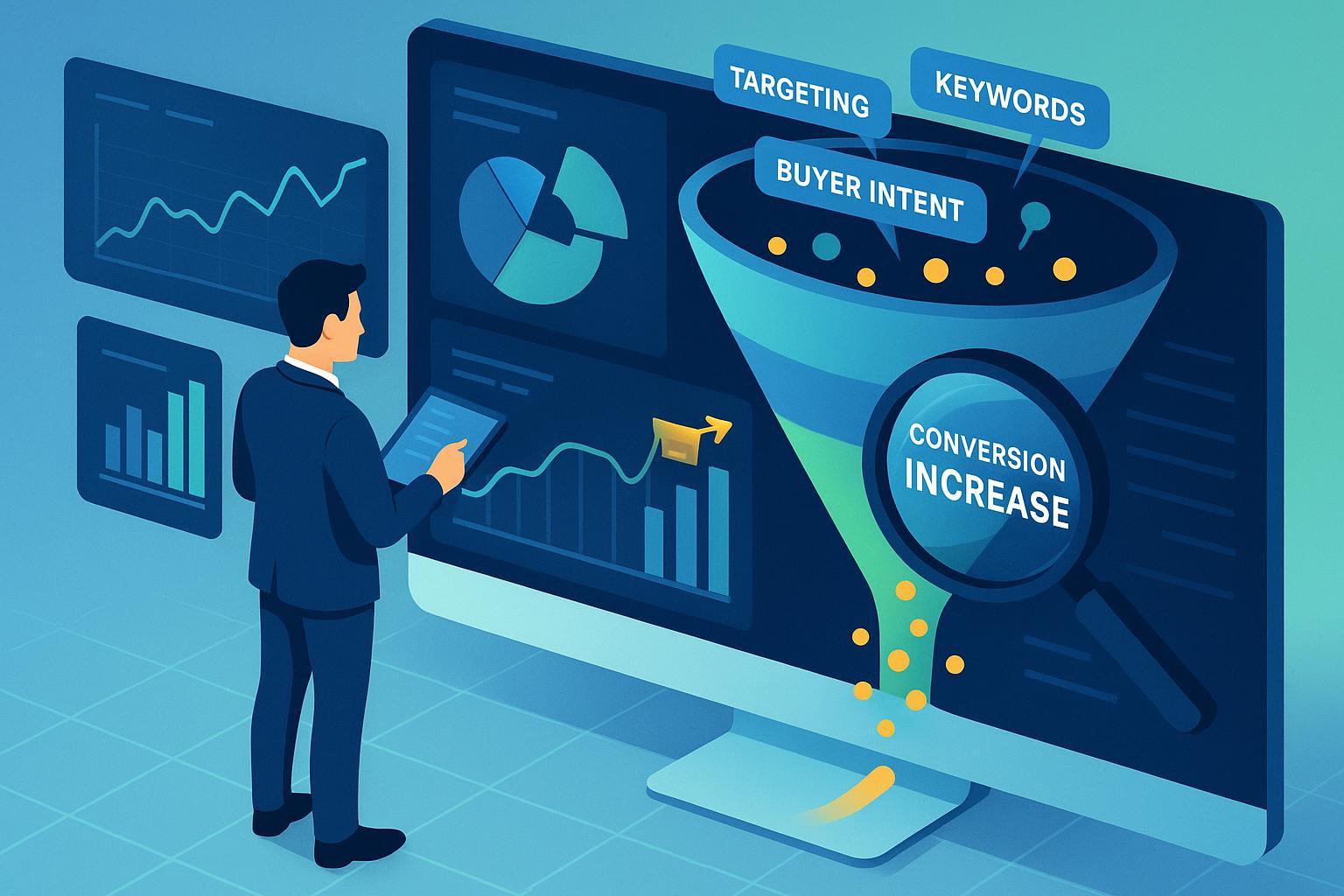Unlocking the Power of Buyer Intent Keywords: Strategies for Increased Conversions

Introduction: Stop Chasing Traffic—Start Driving Revenue
Facing the reality: many marketers see high organic search traffic but minimal conversions. The key? Aligning keyword strategy to buyer intent. According to a CXL study, bottom-funnel content optimized for commercial intent keywords delivers up to 10x higher conversion rates compared to content targeting generic informational terms. This guide distills the most advanced, data-backed best practices for identifying, integrating, and monetizing buyer intent keywords across the funnel—enabling you to turn searchers into revenue.
What you’ll gain:
- 8 actionable best practices, from advanced keyword mapping to measurement
- Conversion benchmarks, data, and workflow diagrams
- Authority resource references and tool recommendations
1. Map Keyword Intent to the Buyer’s Journey Stages
Mapping keywords by intent ensures each stage of the buyer journey—from awareness to decision—receives specifically matched content. Moz recommends segmenting keywords into informational, navigational, commercial, and transactional buckets, aligning each with relevant assets.
How:
- Create a funnel visualization: | Funnel Stage | Keyword Examples | Content Types | |-------------------|-------------------------------|-----------------------------| | Awareness | “What is X?”, “Top strategies”| Guides, Blogs, Infographics | | Consideration | “X vs Y”, “Best tools for…” | Comparisons, Checklists | | Decision | “Buy X”, “X pricing”, “Demo” | Product pages, Demos, Trials|
- Audit your keywords and categorize them accordingly using tools like Ahrefs or SEMrush.
Effect: Brands leveraging journey-specific intent mapping report up to 46% lift in qualified conversions (ADM case).
2. Prioritize High-Intent (Commercial & Transactional) Keywords
Commercial ("best CRM for SMBs") and transactional ("buy CRM software") keywords consistently outperform others in conversion rate. Ahrefs and Search Engine Land emphasize prioritizing these for growth-driven campaigns.
How:
- Identify current top-converting search queries in Google Analytics/Search Console.
- Use intent filters in your keyword tools to extract commercial/transactional keyword opportunities.
- Overlay with paid search data to reveal proven, revenue-driving terms.
Benchmarks: Commercial/transactional intent pages can achieve 5–10x higher conversions than informational pages (WordStream).
3. Leverage Conversion and Voice-of-Customer Data for Validation
Don’t just guess which keywords work: validate using real conversion and customer insight data (WhatConverts).
How:
- Analyze which organic keywords currently convert using attribution reports (look beyond last-click).
- Gather feedback from sales/customer success on what language and problem statements drive sales.
- Use heatmapping and session replay to see which landing pages resonate with high-intent users.
Case Insight: Many SaaS teams shifted budgets after mapping converting queries, improving lead quality by narrowing focus to proven buyer language.
4. Expand and Refine Your Buyer Intent Keyword List with Advanced Tools
Harness advanced tools not just for basic keyword research, but for intent mining, competitive gap analysis, and opportunity discovery.
How:
- Use Ahrefs, SEMrush, or Moz for intent tagging and SERP feature analysis.
- Deploy Demandbase, ZoomInfo, or 6sense for B2B intent data and account-level insights (Intent tool comparison).
- Integrate Leadfeeder or Lead Onion to capture high-intent anonymous visitor data for segmentation.
Tip: Use n-gram and negative keyword mining to exclude low-value terms and improve ROI—a tactic often missed by competitors.
5. Integrate Buyer Intent Keywords Across All Funnel-Aligned Content
Mapping is only the start—embed buyer intent keywords in page titles, H1s, CTAs, and body copy for every funnel stage (HubSpot’s guide).
How:
- Craft and optimize case studies, solution pages, comparison content, demo/trial offers, and transactional pages with the highest-converting terms from your mapped list.
- Ensure internal links propagate buyer-motivated queries from top/mid-funnel guides to bottom-funnel conversion pages.
- Update meta and schema data for commercial keywords to enhance snippet presence and CTR.
Effect: Integrated, journey-aligned optimization leads to more frictionless user paths and measurable uplift, as seen in Pipe Drive’s case.
6. Deploy Advanced Negative Keyword Strategies to Maximize ROI
Removing irrelevant, low-conversion queries is as important as targeting high-intent ones.
How:
- Regularly analyze SERP and search term reports; eliminate ambiguous or non-buyer terms.
- Implement negative keyword lists (using n-grams and pattern-matching) across SEO and paid channels.
- Continuously expand exclusions as you gather more user and campaign data.
Result: A focused set of buyer intent terms improves cost efficiency—key for both PPC and organic ROI.
7. Attribute, Measure, and Optimize for Conversion Outcomes
Benchmarking and measurement are vital. Tie every keyword set to KPIs (leads, sales, pipeline) and continuously update your approach based on performance.
How:
-
Set up end-to-end attribution (from first touch to closed conversion) using analytics tools (e.g., GA4, HubSpot, Salesforce).
-
Analyze conversion rates and pipeline impact for each intent class monthly; compare against industry benchmarks:
Keyword Intent Avg. Conversion Rate Informational 0.7–1.5% Commercial 4–8% Transactional 6–12% (Source: FirstPageSage, WordStream)
-
Double down on what’s exceeding benchmarks; test/optimize or cull what lags.
8. Continuously Test and Iterate with Multichannel Strategies
Modern conversion optimization isn’t just SEO: top performers sequence high-intent keywords through paid search, retargeting, and even email or social.
How:
- Map keyword groups to audience lists for paid search and retargeting.
- Build landing pages specifically targeting recurring buyer intent terms, measure A/B split performance.
- Repurpose high-performing queries in transactional email campaigns and remarketing ads.
Expert Insight: High-intent cross-channel orchestration leads to exponential gains in pipeline volume and quality (Forrester, Gartner studies).
Summary & Next Steps: From Theory to Revenue
By mapping, validating, and operationalizing buyer intent keywords across the full funnel—and consistently measuring impact—you can achieve both immediate and compounding uplifts in conversion and ROI. The data is clear: brands that make the leap from generic traffic to buyer intent-driven strategy see 2.5x–10x higher conversions (Revenue.io).
Your 3-Step Action Checklist:
- Audit your current keyword strategy against actual buyer intent—segment and map!
- Prioritize and deploy high-converting commercial/transactional terms in funnel-matched content.
- Commit to monthly measurement and iterative improvement—benchmark, experiment, and scale.
Want to explore more?
- Download a detailed checklist and workflow template (Moz guide)
- Explore tool documentation and case-study-based frameworks (UserGems comparatives)
Harness buyer intent—and transform your search presence into a true conversion engine.

